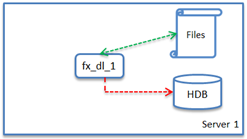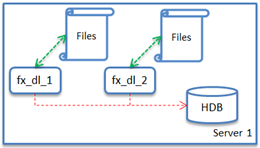Service classes
Service classes are essentially a scalable version of existing Control instances. To support modern, cloud-style architectures, the number of processes is usually not pre-determined. The system needs to behave elastically to meet demand, scaling up when load increases and back down when it eases.
Whereas an instance runs a single process on a single server, a service class can run many processes across many servers. The pre-configured nature of instances also requires a change to its definition in Control in order to change the runtime behavior. Service classes also allow runtime overrides of parameters.
Service classes are configured exactly like instances; they are associated with a template, have a set of parameters, and can be packaged, permissioned and versioned. The running process is called a service and only exists while it's running.
Example lifecycle
It might be helpful to describe a sample lifecycle of a service class from development to production. Assuming a user is creating an FX solution and initially wants to create a scalable data loader service.
In development the user will create a data loader service class from the named fx_dl from the DS_FILEWATCHER template. The class parameters are set, e.g. 3 secondary threads, analytics, schemas, initial state function, polling interval, file config etc. After the configuration of the class is complete, the user runs the service a few times to test the behavior. Once this is complete, the class is packaged and released.
After completing QA and any other interim steps, the class is deployed to production. A data loader service is started by a user or by the system itself. As before, this creates a service from the fx_dl class, inheriting the parameters. The target server and port are chosen by the user or automatically assigned at runtime. At this point, the DL service performs its job, writing data from files to a HDB location on-disk.

At some later point, a batch of new DL files needs to be handled. The workload is too large for a single DL so they should be handled by a second fx_dl service. All of the parameters of the new service will be identical except for the file config as it needs to handle different files. At runtime, the fx_dl service is instantiated again but with an override for the file config parameter. When the service runs, it targets a different set of directories for a different set of files but still uses the same schema, analytics, 3 secondaries etc.

Client entry points
Service classes will be exposed to clients as dynamic connection groups through the query components; QR and QM. The main difference with standard connection groups is that the component processes are not pre-configured. When a new service starts, it will be added to the group in the those frameworks. Clients will target the service class name and the frameworks will target the underlying processes according to the cluster mode. This cluster mode is similar to the connection group type and is defined with the service class definition. It dictates which processes are selected when a request is received.
Service runtime
The main interface for users managing process is the Control UI. Services can be launched from here or directly on the server using the startService scripts.